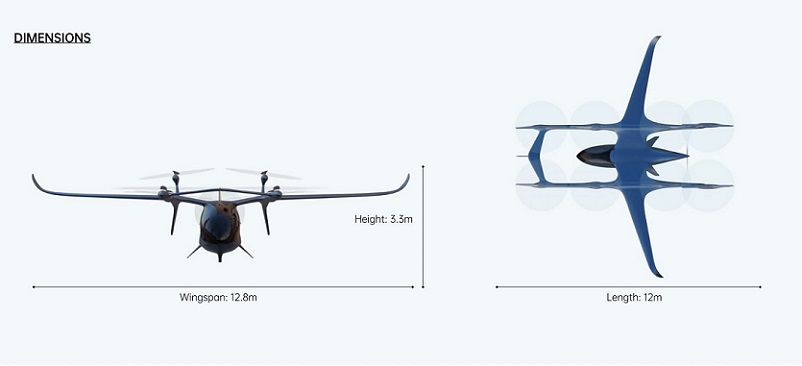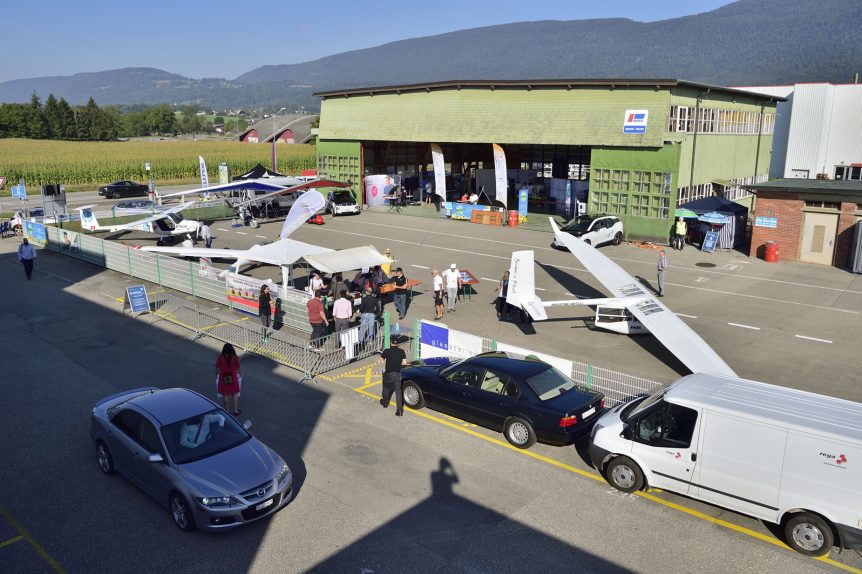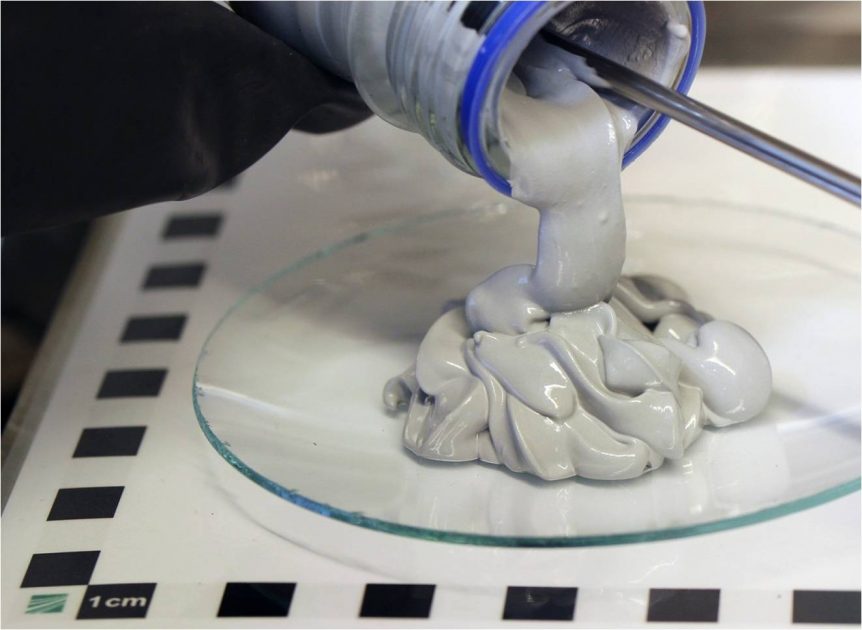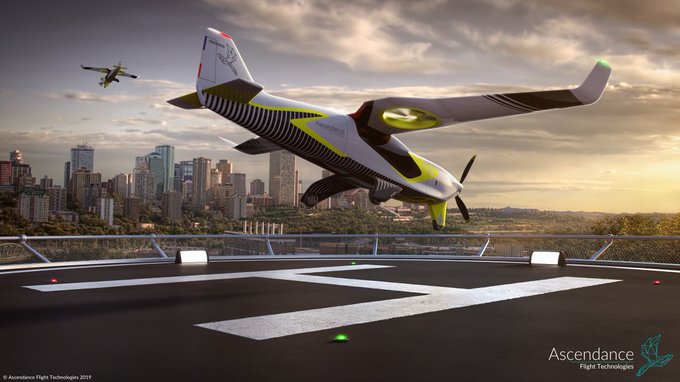AutoFlight, the Chinese firm founded by Tian Yu (Yuneec), celebrated two milestones, although maybe not “firsts” as described in the company’s press releases. Both, however, are impressive and worthy of note. First Intercity Flight AutoFlight claims to have flown the first inter-city electric air-taxi demonstration flight between the southern Chinese cities of Shenzhen and Zhuhai. In an autonomous trip, AutoFlight’s five-seat Prosperity eVTOL (electric Vertical Take Off and Landing) aircraft flew the 50km (31 miles) route from Shenzhen to Zhuhai. The flight across the Pearl River Delta took just 20 minutes, a journey that would require three hours by car. For those with the funds to make the flight the difference in time is incalculable. According to the company, “This marks the first public flight of an eVTOL aircraft on a cross-sea and inter-city route, spanning across the bay where the Pearl River meets the sea, connecting the two southern Chinese cities.” In 2021, Australians flew a Pipstrel Alpha Electro …
Electrifly-in: Grenchen 2021
Electrifly-in, formerly the Smartflyer Challenge, is on for September 11 and 12, 2021, in Grenchen, Switzerland. The event, even held in 2020 despite the pandemic, is a compact showing of the latest in electrical aircraft and technology. Watch as this 2019 video as a Φnix (the Greek letter phi + nix –a clever bilingual pun) takes off, circuits the area and makes a landing – all the time flying with other electric aircraft. In this flight, you can see the compact airport (including a grass landing strip) and a lovely setting for a great event. Started as the Smartflyer Challenge* in 2016, the gathering has changed its name to be more inclusive. Last year, even with travel limitations imposed worldwide, saw a healthy turnout of all-electric flyers, ranging from ultralight electric “trikes” to cross-country tourers. From 12 to 50 Kilowatts and Beyond Powering a large number of machines on last year’s flight line, Eck-Geiger Engineering makes a range of motors …
Hydrogen as a Goop? Fraunhofer’s Powerpaste
Not Gwyneth Paltrow’s Goop What if a different approach to storing hydrogen as a fuel gave benefits that are easily disbelieved? Would this new fuel find approval and widespread adoption? Ask the Fraunhofer Institute for Manufacturing Technology and Advanced Materials (IFAM) in Dresden, Germany. The Institute has come up with something called Powerpaste, claimed to be, “A safe way of storing hydrogen in a chemical form that is easy to transport and replenish without the need for an expensive network of filling stations.” (Fraunhofer describes the paste as a “goop,” not to be confused with the very different fluids marketed by Gwyneth Paltrow under the “Goop” trade name.) We’ve seen hydrogen flying for several decades, with Michael Friend leading a Boeing project to launch the first fuel-cell powered craft in 2008 and Gérard Thevenot flying his H2 fueled “trike” across the English Channel in 2009 using only 550 grams per hour on his crossing, which took a little over an …
HyPoint and Hydrogen Flight
Their web site proclaims, “HyPoint, Inc. is developing the next generation hydrogen fuel cell system with zero CO2 emissions and game-changing energy performance for the air transportation and urban air mobility market.” Pointing out a “fundamental barrier at a chemistry level” for lithium-ion batteries, the fuel cell maker launches some seemingly outrageous claims. HyPoint states, “Our patented technology increases operational time and utilization rate while decreasing TCO (total cost of operation) of any flying platform.” They claim “5X operational time, 10X utilization rate, 20X faster charge,” and a TCO 90 percent of equivalent battery-powered systems. As we have reported here, demonstrated outputs for lithium-ion cells are around 350 Watt-hours per kilogram, and about 260 Whr/kg at the pack level. HyPoint says it can already demonstrate a system-level specific power of 1,000 Watts per kilogram and an energy density of 530 kW-hr/kg. The company points to its next generation of “turbo air-cooled” units to produce even more power and show better energy density. These improvements would make the …
Atea Looks Like a Cessna Overhead
French company Ascendance Flight Technologies offers a four-seat design that combines hybrid propulsion with vertical takeoff and landing capabilities, and then scoots around on conventional wings. Etea’s technology seems a lot like that of Pipistrel’s 801 or several other eVTOLs. Some Historical Perspective The design team at Ascendance comes from Airbus, and claims to have made the first electric aircraft flight across the English Channel with the E-Fan 2.0. Your editor offers a few minor inclusions. First, as we reported on October 10, 2009, “Gerard Thevenot, a long-time championship-level hang-glider pilot, celebrated the centennial of Louis Bleriot’s flight across la Manche by flying his hydrogen-powered La Mouette hang glider over roughly the same route Bleriot took between Calais and Dover on August 6, 2009. Missing the centenary by a few days (Bleriot made the hop on July 25, 1909), Thevenot took an hour and seven minutes to duplicate the trip Bleriot managed in 37 minutes.” It was an Eck/Geiger propelled machine, …
Solar Sails for Ultralights?
Ultralights have done many spectacular things, including topping Mt. Everest and crossing the English Channel. Gerard Thevenot flew the Channel under a La Mouette wing powered by an Eck/Geiger motor driven by three fuel cells in 2009 – six years before the recent flights with faster electric craft. For that matter, Paul MacCready and his team flew a solar-powered aircraft from near Paris to an RAF runway on the eastern English coast in 1981. Hang gliders, paramotors, and other rigid and non-rigid-wing craft might benefit from new sailcloth that incorporates flexible solar cells into its makeup. Used on sailboats, the solar fabric helps run auxiliary motors and can help extend the cruising range of a boat when the sails are furled. A French company named UK Sailmakers France has started a new company, SolarClothSystem®, to make mainsails with “a film containing high efficiency photovoltaic cells.” The solar cells can be used on sails that will be rolled or folded, as …
Floating Over the Danube: The Vision of the Little Tailor of Ulm Lives
The beautiful blue Danube River of Strauss waltz fame, “…Rises in the Black Forest mountains of western Germany and flows for some 1,770 miles (2,850 kilometers) to its mouth on the Black Sea. Along its course, it passes through nine countries: Germany, Austria, Slovakia, Hungary, Croatia, Serbia, Bulgaria, Romania, and Ukraine,” according to the Encyclopedia Britannica. In 1811, Albrecht Ludwig Berblinger, a tailor in the city of Ulm near the headwaters of the second longest river in Europe, tried a novel idea – flying across the river on a nicely sewn-together hang glider. His splashdown marked the end of his aeronautical career, but made him famous and an unlikely harbinger of things to come. City fathers have announced, “In the spirit of Berblinger, and continuing his vision, the City of Ulm aims to promote innovative developments in general aviation that makes it possible to perform an environmentally sustainable long-distance flight. The long-distance objective is a competition flight following the course of the Danube along its whole length from source to mouth, as free of …
Hydrogen Scooters – A Possible Power Source?
Amateur aircraft builders, like Francis Marlier of the ULM Club in Alsace, France who recently converted his Exelec to a Sunexelec with the addition of solar cells, are always looking for reasonable options for powering their airplanes. Perhaps they could turn to fuel cells as a range extender. Several motor scooter makers are bringing out fuel-cell powered models that show some promise despite limited performance and high prices so far. Intelligent Energy, an English company, demonstrated a fuel cell scooter in 2005, and a number of aircraft developers, including Boeing, have crafted fuel-cell-powered vehicles. Intelligent Energy’s ENV was reportedly the world’s first purpose-built fuel cell motorbike, and Top Gear’s James May enjoyed the quiet ride, if only moderately endorsing the bike’s sedate performance. http://www.youtube.com/watch?v=igrKemNvxZQ Intelligent Energy’s entry for the Make It in Great Britain exhibit at the Science Museum gives a brief overview of proton exchange membrane fuel cell technology. “This award winning zero emission electric vehicle is powered by Intelligent …
The Kindest Cut of All
In 1811, an inventive tailor in Ulm, Germany attempted a hang glider flight across the Danube River. He failed in the attempt, but it became the stuff of legend and at least one television commercial. Albrecht Ludwig Berblinger (1770-1829) had wanted to be a watchmaker, but was consigned to become a cutter of fabric. Despite this, he used his spare time to invent things like the first jointed artificial leg in 1808. Perhaps his skills with fabric led to his fabricating a pair of wings, essentially a hang glider, Shunned by his fellows for working outside the discipline of tailoring, Berblinger poured his resources into building and testing his glider. Leaping from a scaffold built for the attempt by Prince Frederick on Württemberg Castle’s walls, he attempted to glide to the other side of the too-wide stream. Ending up rescued by nearby boatmen, he was hailed as a hero nonetheless. He died of emaciation (alternately reported as exhaustion) living in …
ENFICA-FC – A Speed Record for Hydrogen
Professor Guilio Romeo of the Politecnico de Torino, Italy is a man of many firsts. Last year, his team fielded Skyspark, a Pioneer 300 powered with an electric motor fed by batteries. This year, in a totally new development, Professor Romeo coordinated the activities leading to a successful hydrogen-powered electric aircraft, and set a world speed record to top off that accomplishment. The Skyleader 150 Zero CO2 light sport aircraft, built by JIHLAVAN airplanes, Ltd. in the Czech Republic, was fitted with Intelligent Energy proton exchange membrane (PEM) fuel cells from the United Kingdom, an inverter and power management system by Italy’s Mavel Elletronica, and a motor at least partially designed by the University of Pisa, Italy. Tanks and a high-pressure fuel delivery system were created by the UK’s Air Products Limited. Labeled ENFICA-FC (Environmentally Friendly Inter City Aircraft Powered by Fuel Cells) the airplane was actually the fourth machine to fly on hydrogen power, the first being a Boeing conversion of a …
- Page 1 of 2
- 1
- 2





